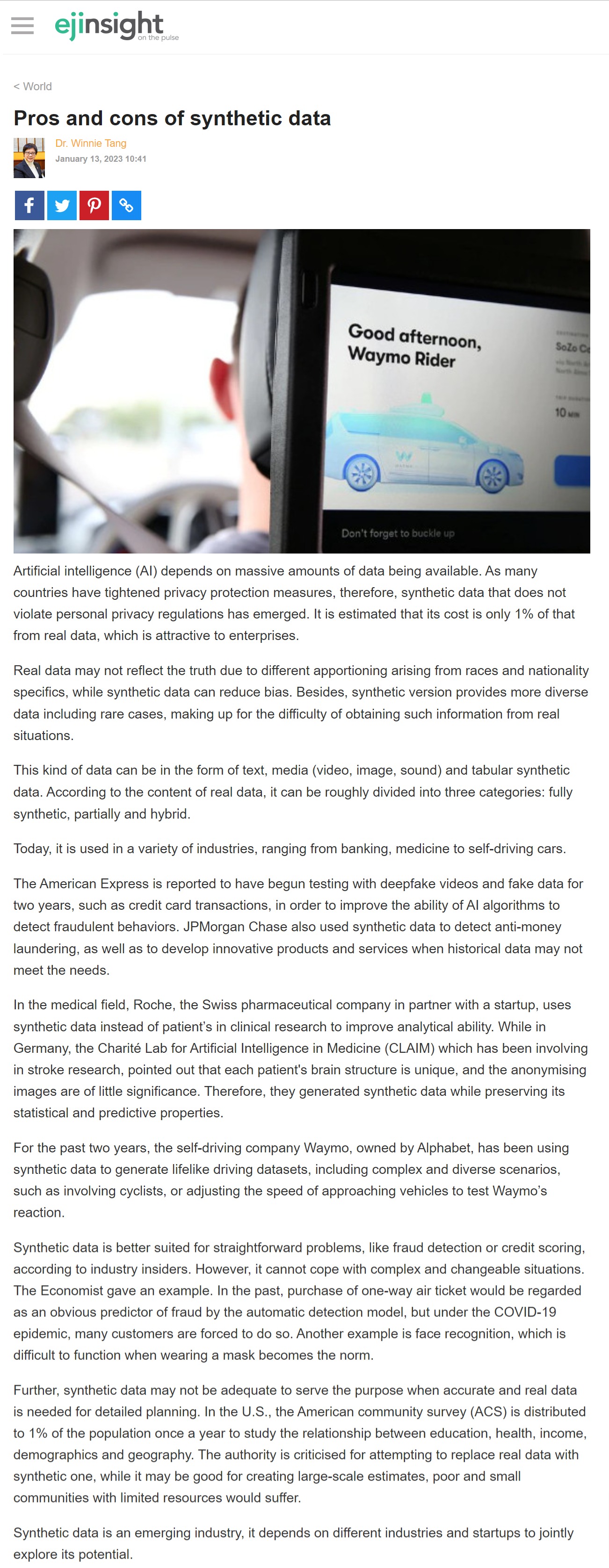網上版請按此

Pros and cons of synthetic data
Artificial intelligence (AI) depends on massive amounts of data being available. As many countries have tightened privacy protection measures, therefore, synthetic data that does not violate personal privacy regulations has emerged. It is estimated that its cost is only 1% of that from real data, which is attractive to enterprises.
Real data may not reflect the truth due to different apportioning arising from races and nationality specifics, while synthetic data can reduce bias. Besides, synthetic version provides more diverse data including rare cases, making up for the difficulty of obtaining such information from real situations.
This kind of data can be in the form of text, media (video, image, sound) and tabular synthetic data. According to the content of real data, it can be roughly divided into three categories: fully synthetic, partially and hybrid.
Today, it is used in a variety of industries, ranging from banking, medicine to self-driving cars.
The American Express is reported to have begun testing with deepfake videos and fake data for two years, such as credit card transactions, in order to improve the ability of AI algorithms to detect fraudulent behaviors. JPMorgan Chase also used synthetic data to detect anti-money laundering, as well as to develop innovative products and services when historical data may not meet the needs.
In the medical field, Roche, the Swiss pharmaceutical company in partner with a startup, uses synthetic data instead of patient's in clinical research to improve analytical ability. While in Germany, the Charité Lab for Artificial Intelligence in Medicine (CLAIM) which has been involving in stroke research, pointed out that each patient's brain structure is unique, and the anonymising images are of little significance. Therefore, they generated synthetic data while preserving its statistical and predictive properties.
For the past two years, the self-driving company Waymo, owned by Alphabet, has been using synthetic data to generate lifelike driving datasets, including complex and diverse scenarios, such as involving cyclists, or adjusting the speed of approaching vehicles to test Waymo's reaction.
Synthetic data is better suited for straightforward problems, like fraud detection or credit scoring, according to industry insiders. However, it cannot cope with complex and changeable situations. The Economist gave an example. In the past, purchase of one-way air ticket would be regarded as an obvious predictor of fraud by the automatic detection model, but under the COVID-19 epidemic, many customers are forced to do so. Another example is face recognition, which is difficult to function when wearing a mask becomes the norm.
Further, synthetic data may not be adequate to serve the purpose when accurate and real data is needed for detailed planning. In the U.S., the American community survey (ACS) is distributed to 1% of the population once a year to study the relationship between education, health, income, demographics and geography. The authority is criticised for attempting to replace real data with synthetic one, while it may be good for creating large-scale estimates, poor and small communities with limited resources would suffer.
Dr. Winnie Tang
Adjunct Professor, Department of Computer Science, Faculty of Engineering; Department of Geography, Faculty of Social Sciences; and Faculty of Architecture, The University of Hong Kong